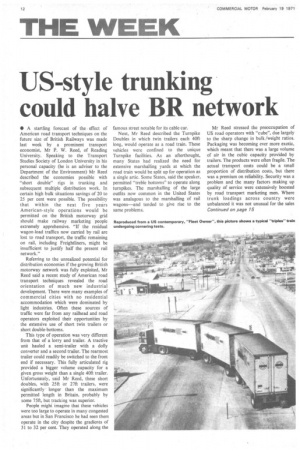US-style trunking could halve BR network
Page 14

If you've noticed an error in this article please click here to report it so we can fix it.
• A startling forecast of the effect of American road transport techniques on the future size of British Railways was made last week by a prominent transport economist, Mr P. W. Reed, of Reading University. Speaking to the Transport Studies Society of London University in his personal capacity (he is an adviser to the Department of the Environment) Mr Reed described the economies possible with "short double" rigs in trunking and subsequent multiple distribution work. In certain high bulk situations savings of 20 to 25 per cent were possible. The possibility that within the next five years American-style operations would be permitted on the British motorway grid should make railway marketing people extremely apprehensive. "If the residual wagon-load traffics now carried by rail are lost to road transport, the traffic remaining on rail, including Freightliners, might be insufficient to justify half the present rail network."
Referring to the unrealized potential for distribution economies if the growing British motorway network was fully exploited, Mr Reed said a recent study of American road transport techniques revealed the road orientation of much new industrial development. There were many examples of commercial cities with no residential accommodation which were dominated by light industries. Often these sources of traffic were far from any railhead and road operators exploited their opportunities by the extensive use of short twin trailers or short double-bottoms.
This type of operation was very different from that of a lorry and trailer. A tractive unit hauled a semi-trailer with a dolly converter and a second trailer. The rearmost trailer could readily be switched to the front end if necessary. This fully articulated rig provided a bigger volume capacity for a given gross weight than a single 40ft trailer. Unfortunately, said Mr Reed, these short doubles, with 25ft or 27ft trailers, were significantly ' longer than the maximum permitted length in Britain, probably by some 75ft, but tracking was superior.
People might imagine that these vehicles were too large to operate in many congested areas but in San Francisco he had seen them operate in the city despite the gradients of 31 to 32 per cent. They operated along the famous street notable for its cable car.
Next, Mr Reed described the Turnpike Doubles in which twin trailers each 40ftlong, would operate as a road train. These vehicles were confined to the unique Turnpike facilities. As an afterthought, many States had realized the need for extensive marshalling yards at which the road train would be split up for operation as a single artic. Some States, said the speaker, permitted "treble bottoms" to operate along turnpikes. The marshalling of the large outfits now common in the United States was analagous to the marshalling of rail wagons—and tended to give rise to the same problems. Mr Reed stressed the preoccupation of US road operators with "cube", due largely to the sharp change in bulk /weight ratios. Packaging was becoming ever more exotic, which meant that there was a large volume of air in the cubic capacity provided by trailers. The products were often fragile. The actual transport costs could be a small proportion of distribution costs, but there was a premium on reliability. Security was a problem and the many factors making up quality of service were extensively boosted by road transport marketing men. Where trunk loadings across country were unbalanced it was not unusual for the sales Continued on page 15





























